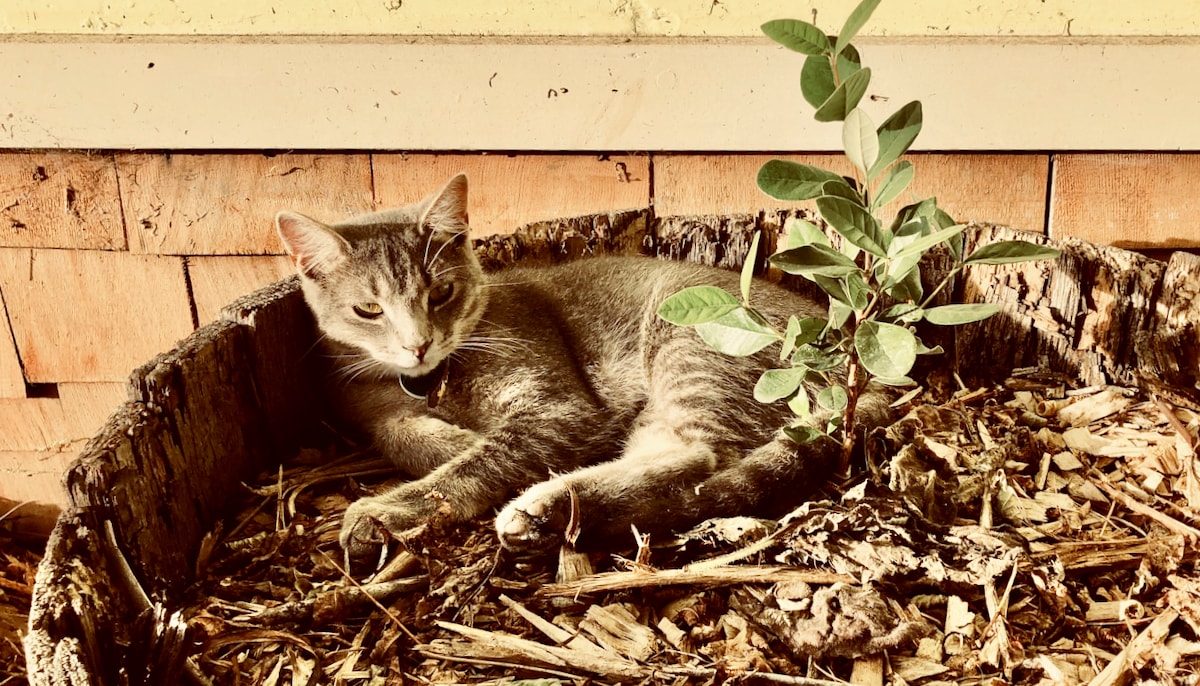We named our cat Birdy after the sweet bird-like sounds he made when he was cozy and content, which was nearly all the time. A little ball of soft gray fur with kind eyes that would blink slowly at you in friendly recognition, he exuded sweetness, joy, and gratitude. He was six months old when we adopted him from a local rescue, and he was eight months old when he died.
That afternoon, unseasonably warm and dry for Northern California in November, I was making butternut cranberry muffins, and he jumped up on the kitchen counter to sneak a taste of batter. I scolded him sweetly, kissing the top of his head as I scooped him up and put him down, and then he slipped out the back window to play in the sun. Half an hour later, the muffins just out of the oven, a neighbor knocked on our door to ask if we had a gray cat. “Have you seen Birdy?” my husband asked me on his way out the door. Outside the woman whose car had hit him was sobbing beside his little body on the sidewalk. In an instant it had happened, and he was already gone. It seemed impossible.
I’d spent days sitting with notions of ecological grief, and now suddenly a more personal grief seized me.
A few hundred miles away, the Camp and Woolsey fires had been raging for several days, consuming places and landscapes and memories and lives. I’d spent those days sitting with notions of ecological grief, and now suddenly a more personal grief seized me as I grappled intimately with shock and loss and change. Cradling Birdy’s little body in our arms, still warm from the vibrant life that had just left it, my husband and I wept.
Over the next few days, the loss from the fires continued to mount, the human death toll ticking upward with hundreds more missing, and thousands of animals dead or injured. This, of course, situated in the broader context of climate chaos fueling suffering everywhere in the world. As we grieved for Birdy, we grieved for all beings, human and nonhuman, nearby and far away.
And questions arose: How do we consciously join our personal grief with collective grief? How do we hold it, tend it, share it, use it as a pathway for healing? How do we avoid disassociation and numbness when opening to what feels so painful, so overwhelming, so immense?
In relating our suffering, we can begin to see clearly that nothing is separate.
In the days that followed I found the most accessible and immediate way to relate these forms of grief, to allow emotions to rise up and move through, to begin the healing process was to engage the practice of tonglen. Meaning “sending and taking,” tonglen is an ancient Buddhist practice meant to awaken compassion. As we inhale, we breathe in suffering, our own and that of all those experiencing the same; as we exhale, we breathe out relief.
This practice calls us to invite in life exactly as it is, the suffering and the joy and the everything-in-between; to connect our personal experiences with those of all beings; to cultivate presence and radical acceptance, a place from which our wakeful work can begin; and to send healing energy out into the world.
In relating our suffering, we can begin to see clearly that nothing is separate; we are radically interconnected and interdependent. Grief and love, too, are not separate; joy and sorrow are one and the same. As Kahlil Gibran writes in The Prophet:
“When you are joyous, look deep into your heart and you shall find it is only that which has given you sorrow that is giving you joy. When you are sorrowful look again in your heart, and you shall see that in truth you are weeping for that which has given you delight.”
Artist and photographer Chris Jordan similarly says in his film Albatross, “grief is a felt experience of love for something we are losing or have lost.” And as author and activist Terry Tempest Williams writes, “grief dares us to love once more.” Perhaps this place of grief-as-love, then, is our starting point, our doorway to transformation, both individual and cultural.
And so I breathe in grief and breathe out love, blurring the distinction between the two. I feel life as it moves through me, so precious and so fragile, and I bow humbly in gratitude – for this breath and this life, for awareness and connection, for all beings and for Birdy.

